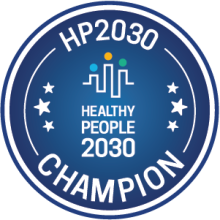This blog post is the first in a quarterly series highlighting the work of Healthy People 2030 Champion organizations. Healthy People 2030 Champions are organizations recognized for their work to improve the health and well-being of people in their communities and to help achieve Healthy People 2030’s goals.
The Iowa Department of Health and Human Services (HHS) has a clear mission: to protect and improve the health and resiliency of individuals, families, and communities in Iowa by providing high-quality programs and services. To realize this mission, Iowa HHS follows a data-driven approach — and looks to Healthy People to guide its efforts.
“We constantly work to build the connections between our programming at Iowa HHS and Healthy People 2030. We use Healthy People 2030 as our ‘North Star’ for state health improvements,” says Jonn Durbin, team leader of Healthy Iowans at Iowa HHS. Healthy Iowans is a collaborative process that includes Iowa’s state health assessment (SHA) and state health improvement plan (SHIP). Every 5 years, the Healthy Iowans team assesses the state’s progress toward desired health outcomes and identifies priorities and strategies to improve the health of people in the state.
Using LHIs to Inform State-Specific Health Objectives
Healthy People 2030 Leading Health Indicators (LHIs) are an important part of the Healthy Iowans process. Specifically, Healthy Iowans uses LHIs as measures of health improvement — and adapts them into objectives that reflect Iowa’s unique health priorities.
For example, Healthy Iowans 2017–2021 identified the LHI NWS-01: Reduce household food insecurity and hunger as a health priority, created state-specific objectives related to the issue, and used state-level data to track progress. And that progress is apparent — in 2019, the Healthy Iowans team noted a nearly 22 percent decrease in the rate of Iowans experiencing food insecurity (from 12 percent in 2015 to 9.4 percent in 2019).1 Through a variety of unique programs, organizations in counties throughout the state contributed to this progress. For example:
- To help overcome the problem of food deserts for older Iowans living in rural areas, Lee County established 7 sites where local food producers, growers, and farmers market vendors can donate produce.
- The Dallas County Food GRID established a pop-up produce stand in communities that lack access to healthy grocery options. The stand features produce at wholesale prices so it’s more affordable for families with lower incomes.
- In Story County, the Hunger Collaboration developed the BackPack program, which provides hundreds of children in school districts across the county with bags of food for the weekend.
When it comes to meeting state health objectives, Durbin says the key to success is to “find state- and county-level data for LHIs and help local agencies find the measures that match them as closely as possible.” He says this helps ensure that Healthy Iowans’ objectives are aligned with national health priorities while still reflecting the state’s specific focus areas.
Getting the Word Out: Scan and Refer
To connect with its partners and align on public health priorities, the Healthy Iowans team offers a service called “scan and refer.” As part of this service, Dr. Louise Lex, the Healthy People coordinator at Iowa HHS, regularly shares new research reports, training opportunities, and other resources with Healthy Iowans’ network. This network includes a wide variety of partners — including nonprofits, governmental agencies, businesses, educational institutions, and other types of organizations.
In her communications with partners, Lex highlights the connections between the content she’s sharing, Healthy Iowans, and Healthy People. “The success of public health efforts relies heavily on the dissemination of accurate, comprehensive, and timely information,” Lex says. “Public health is an ever-evolving field, and it is our responsibility as public health professionals to stay up to date. ‘Scan and refer’ helps make that possible.”
Looking to the Future: Healthy Iowans 2023–2027
Based on the results of its 2021–2022 SHA, Healthy Iowans’ 2023–2027 SHIP identifies several focus areas with strong ties to Healthy People 2030 LHIs. One focus area in particular — healthy eating and active living — connects to national health priorities such as the National Strategy on Hunger, Nutrition, and Health and efforts to promote physical activity, like the Move Your Way® campaign. Healthy Iowans 2023–2027 lays out 2 goals for this focus area to improve the health of people in the state:
- Reduce barriers to affordable, nutritious foods for all people in Iowa
- Increase engagement in active living among all people in Iowa
Iowa HHS will continue to work with its partners and communities across the state to make progress toward these goals.
Lessons Learned
Finally, Durbin shares tips for other public health organizations to successfully implement health improvement strategies and to use the Healthy People framework to support their efforts. “Using these strategies has helped us keep close to 100 organizations involved with Healthy Iowans over time,” says Durbin.
Be a data champion.
- Find state measures that align with LHIs and help local agencies find measures that match LHIs as closely as possible. For example, try using sources like County Health Rankings and the U.S. Census Bureau.
- Track these measures and document data and sources in regular progress reports (like Iowa’s SHIP).
- Continuously look for opportunities for quality improvement.
Document and communicate.
Document your assumptions, the steps you took, hurdles you faced, and decisions you made — that way, you can communicate them broadly, clearly, and consistently.
Be consistent.
When people know what to expect, they’ll be more comfortable participating and will be better equipped to find ways to move the needle toward better health.
1 Iowa Department of Public Health. (2021). Healthy Iowans: Is Iowa’s health improving? Des Moines: Iowa Department of Public Health. Retrieved from: https://publications.iowa.gov/38313/1/Healthy%20Iowans%20Is%20Iowa%27s%20Health%20Improving%20July%202021.pdf [PDF - 10.9 MB]
Related Healthy People 2030 objectives:






